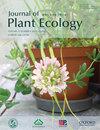互生关系中不对称和不确定的相互作用
IF 3.9
2区 环境科学与生态学
Q2 ECOLOGY
引用次数: 0
摘要
尽管在过去的几十年里,对互惠关系稳定性的理解已经取得了进展,但在解释互惠关系如何保持稳定方面仍然存在两个基本问题。1)如何解决互惠主义者之间的资源冲突? 2)在存在不太合作和/或不合作的共生体时,如何防止共生体种群被不合作的个体统治?过去许多关于互惠稳定的解释都假设互惠者之间的相互作用是对称的。然而,在大多数共生关系中,寄主和共生体之间的相互作用在不同水平上表现出不同程度的不对称。在此,我们回顾了专性共生关系中的三种主要类型的不对称相互作用:i)不对称收益,也被定义为个体权力差异;ii)不对称进化变化的潜在速率;iii)宿主和共生体之间的不对称信息状态。我们认为,互利共生体之间的这些不对称有助于解释为什么合作和冲突是互利共生进化中固有的,以及为什么宿主和共生体都呈现出多样化的表型,而合作占主导地位。本文章由计算机程序翻译,如有差异,请以英文原文为准。
Asymmetric and uncertain interactions within mutualisms
Although understanding mutualism stability has advanced over the last few decades, two fundamental problems still remain in explaining how mutualisms maintain stable. 1) What resolves conflict between mutualists over resources and 2) in the presence of less cooperative and / or un-cooperative symbionts, what prevents symbiont populations from becoming dominated by un-cooperative individuals? Many past explanations of mutualism stability have assumed that interactions between mutualists are symmetrical. However, in most mutualisms, interactions between hosts and symbionts show varying degrees of asymmetry at different levels. Here we review three major types of asymmetric interactions within obligate mutualisms: i) asymmetric payoffs, which is also defined as individual power differences, ii) asymmetric potential rates of evolutionary change, and iii) asymmetric information states between hosts and symbionts. We suggest that these asymmetries between mutualists help explain why cooperation and conflict is inherent in the evolution of mutualisms, and why both hosts and symbionts present diversified phenotypes whilst cooperation predominates.
求助全文
通过发布文献求助,成功后即可免费获取论文全文。
去求助
来源期刊

Journal of Plant Ecology
生物-植物科学
CiteScore
4.60
自引率
18.50%
发文量
134
审稿时长
3 months
期刊介绍:
Journal of Plant Ecology (JPE) serves as an important medium for ecologists to present research findings and discuss challenging issues in the broad field of plants and their interactions with biotic and abiotic environment. The JPE will cover all aspects of plant ecology, including plant ecophysiology, population ecology, community ecology, ecosystem ecology and landscape ecology as well as conservation ecology, evolutionary ecology, and theoretical ecology.
 求助内容:
求助内容: 应助结果提醒方式:
应助结果提醒方式:


